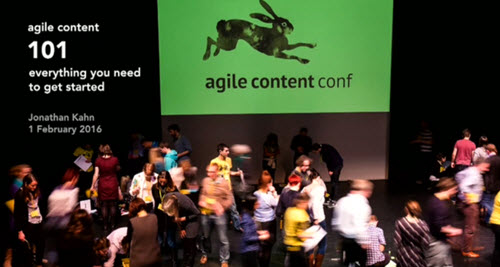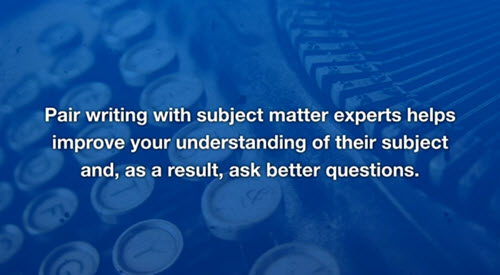Getting agile with content creation at the Agile Content conference
Last week I spent a couple of days in London at the Agile Content conference. I was really keen to attend, as the conference focus seemed to be the issue that constantly challenges me in my role – how do we work together to build effective, user-focused content?
I was not disappointed – at the end of the event I came away with not only a clearer understanding of the issues but also with a number of useful techniques to help me tackle them and an action plan to put it into practice.
The event took place over two days – a conference day and a workshop day – at the Sadler’s Wells Theatre, London. It was a great venue. Being inside such a hub of cultural creativity certainly helps to inspire creative thought (as well as providing the best conference lunch I’ve ever had)!
Why Agile content?
The aim of the conference, led by Johnathan Kahn from Together London, was to: ‘learn practices to help teams work together on content’. Seems straightforward enough? Indeed the notion of working together to build effective, user-focused content seems hard to disagree with, except it’s not always that easy… People have different ideas of what their website is for, who it’s aimed at and how it should speak to them and if they can’t agree on these fundamentals the resulting site can pull in so many different directions that it’s no use to anybody.
So here’s where taking an agile approach to content creation could be helpful. Agile content is inspired by Agile development – something we’re familiar with here in UWP as it’s the approach taken with the EdWeb project – and takes the spirit of Agile and combines it with other techniques to foster an environment of collaboration to support successful content creation.
Bruce’s post on using an Agile approach to the EdWeb project
Conference organiser Johnathan Kahn summed up what Agile content is and how it can help in his opening presentation:
Agile content 101 – everything you need to get started
‘In conversation’ sessions
The conference focused on three different techniques to encourage successful collaboration on content:
- Pair writing
- User stories
- User research
For each of these there was an ‘in conversation’ session, which explored the techniques and gave examples of how they could be applied in practice.
Use pair writing to work together with subject matter experts – Rebecca Mallon, Citizens advice
Rebecca talked about her experience of using pair writing – where two people, typically a subject matter expert (SME) and a content professional sit together to write content as an alternative to the traditional approach of sending email drafts back and forth – to produce a user-focused page or piece of content with hopefully quicker and better results.
Practical examples of how techniques have been applied are always helpful to encourage us to think about the challenges of how they could work for us. Rebecca’s top tips for pair writing were:
- Make the sessions work for you (don’t have to stick too rigidly to principles)
For example, one of their SMEs was based in a different UK location so the approach had to accommodate this.
- Brief the SME beforehand/set ground rules.
Make sure you’ve agreed how things will work. Rebecca’s example here was about how with hindsight, agreeing how/if drafts could be accessed between sessions would have been helpful.
- Choose your allies to prove the process works.
Rebecca’s initial PW sessions took place with two selected subject areas who were already invested in the process.
For me, a key takeaway was that the control and ownership of the content stays with the site owner so even if there wasn’t always a pair-writing process they would hopefully still have picked up the additional skills to apply when writing their content. We’re already teaching these guiding principles in the Writing for the Web course we run for web editors within the University, but this process offers another practical way to help to embed them in content creation process.
Use pair writing to work together with subject matter experts
Rebecca’s slide reads: Pair writing with subject matter experts helps improve your understanding of their subject and, as a result, ask better questions.
Write user stories to share responsibility for content – Sarah Richards
In Sarah’s session she talked about the usefulness of user stories to build shared understanding. Again, user stories are familiar as an Agile technique through the EdWeb development project and I’ve seen them usefully employed in a UX context, such as in the recent IGMM strategy workshop Neil ran. In relation to content creation, if you can collaborate with your website stakeholders to produce user stories for your key pages you then have clarity of what that content is there to do.
My post about Neil’s IGMM website strategy workshop
Couple this with evidence-based content discovery methods – using sources such as forums, analytics and subject experts to bring together audience research findings on language, information architecture and thought processes and you have a pretty solid base on which to build your content.
Sarah’s top tips slide:
- Try it – ask forgiveness, not permission
- Practice – safe environment
- Remember everyone is human
- Designing with data is always easier
I loved the idea of using the user research data to steer your content design and help to diffuse some of the more awkward conversations where there are differing views. While everybody’s perspective is valid, your user research can help to ensure that user needs remain the priority.
Write user stories to share responsibility for content – Sarah Richards
Help colleagues to understand needs through user research – Lily Dart
Lily’s session reminded us all of the value of trying to see things from the user perspective because
You know things you forget that you know
Rather than a rundown of user research techniques, Lily talked about taking the time to get under the skin of issues around user research in order to get the best results. For example, ensuring the right people are round the table to take in the results of user research is crucial if you want to see findings turn into actions and improvements.
Also, try to understanding why stakeholders may be reluctant to get involved in user research? Exploring what they feel the risk is can help to work towards resolutions that everyone can support.
When asked which user research technique she would be most likely to recommend, Lily suggested the focus should be on the question being asked and how this should drive the choice of technique to deliver more focused and useful results.
Help colleagues to understand needs through user research – Lily Dart
Conference day workshops
Sandwiched in between Sarah and Lily’s presentations we had an opportunity to put some of these techniques into practice with two workshops, the first on user stories and pair writing and after refuelling with coffee, a chance to have a go at ‘active listening’.
In the first workshop session, we worked in pairs to create user stories about an allocated web page. Having the content selected for us to play with meant everyone had the same attachment to it and removed the risk of people being protective of their ‘own content’.
Once user stories had been written and prioritised using the trusty sticky dots technique, we set to work with pair writing. As someone experienced in creating online content it’s a little challenging to work with someone literally looking over your shoulder and not get prickly about it. However, if you can embrace it as a different way of working the potential time savings and improved content certainly made it worthwhile.
Likewise with the second workshop, in which we discovered what an active listening model looks like (as compared to others such as ‘deflecting’ on to our own experiences, or ‘fixing’, where we immediately leap in to offer a solution).
Again, while not necessarily a comfortable technique initially, working in pairs and taking it in turns to experience these different listening models from both the speaker and listener perspectives, made us look closely at how we interact with one another. It was noticeable that while each model can have its positives, taking a more reflective approach when working with our colleagues can allow them to explore their issue more deeply and support them to identify blockers and potential solutions.
Conference takeaways
The following workshop day we were a more select bunch with relatively few of us there. This turned out to be great opportunity however, as we were able to really dig into next steps and how to turn our conference experiences into practical actions when we returned to our respective workplaces.
For me the priority would be building confidence with using the pair writing technique. I can definitely see the value in adding this to the toolbox when working together with teams around the University or supporting them to use it among themselves.
Sometimes the scale of the University and our devolved approach to publishing can make the thought of trying to implement new techniques or try different ways of working daunting. I was encouraged however to hear success stories from speakers and attendees at this conference working in or with comparably scaled organisations with equally complex content challenges – GDS, HMRC and Citizens Advice for starters.
A useful tip was to start small and get confident, making mistakes among friendly faces. If you can ‘show not tell’ people the benefits of an Agile approach to improving content, we can support a model of collaboratively building successful content that meets our users’ needs.
If you’re interested in taking a collaborative approach to improve your website content, get in touch with me to explore how we could work together.






4 replies to “Getting agile with content creation at the Agile Content conference”